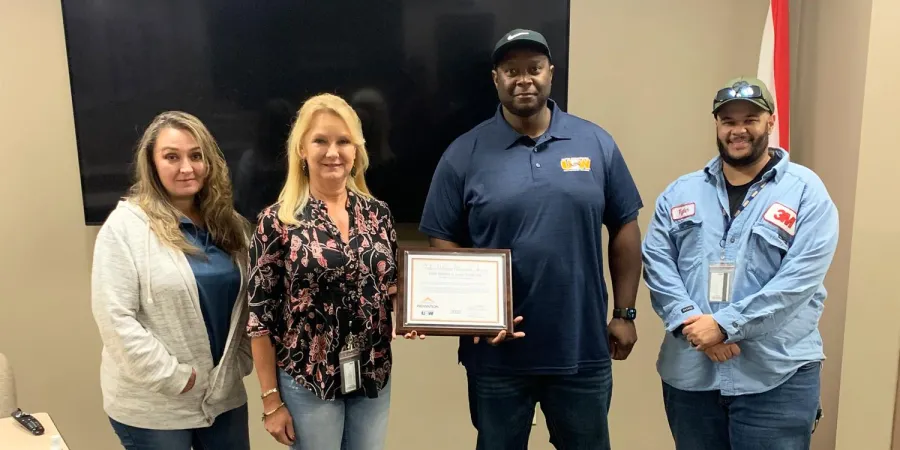USW Local Union 9-675, TOP site in Alabama receives Fallen Workers Memorial Award

Labor activists, especially union members who spend their days on workshop floors, are in many ways like environmentalists. They both conceive of their immediate environment as a complex web of interrelated energies that must be understood in fine detail. In the case of plant workers, health and safety teams spend a lot of time tracking the state of machinery, infrastructure and work procedures that might lead to adverse events like injury. And like environmentalists, union members look to widen their coworkers’ (as well as the public’s) perspectives on the root causes of adverse events. Simply put, the conditions by which work gets done must be understood in its entirety, free from the biased demands of pure production. But all this knowledge and passion for the well-being of others, depends one thing: education.
Enter United Steelworkers (USW) Local Union 9-675 in Guin, Ala. The Local has been partnering with 3M Guin chemical plant through the Triangle of Prevention (TOP) program since 2003. TOP is a union-led, company-supported health and safety program which focuses on a USW Systems of Safety approach to incident investigation. TOP also looks at measuring and tracking incidents and near-misses to prevent future accidents. And this last August (2022), health and safety activists at Guin received the two highest awards that the Tony Mazzocchi Center for Health, Safety and Environmental Education (TMC) can bestow on a TOP site: the Fallen Workers Memorial Award, marking excellence in the pursuit of workplace hazard resolution, and the TOP flag as an award, which recognizes the most completed training sessions per year by a TOP program.
Angie Mayo, who has worked at 3M Guin for over 25 years, and has been the TOP lead coordinator for 3M Guin since 2020, said, “back in the day, we had so many recordable injuries that the company was on the edge of shutting the plant down.”
“We were facing a crisis and had no time to think small,” she said, “we needed to go big.”
Going big meant turning to one of the most robust injury prevention programs the USW offers to its members: the TOP program. Mayo knew that the only way to ratchet down the injury rate was to dramatically increase the number of training being done at the plant.
“Not only did we need very targeted training like Incident Investigation [a training curriculum that teaches workers to look for root causes to incidents], but we also needed (and still need!) to find more fluid ways to interact with the shop floor,” said Mayo.
“We needed hazard spotters and a reporting system that operates in real-time,” said Mayo.
Below is a snapshot of what this TOP site has achieved in the last few years:
- Of 340 workers, 340 receive yearly TOP Awareness refresher training
- 330 workers received Hazardous Waste training this year alone
- Every new hire receives training within weeks of starting
- Two Hazardous Waste refresher classes are done every week
- Ongoing recruiting of “investigators” (workers who track hazards)
- Team currently has 16 hourly workers and 20 salaried workers as active investigators
- Hazard Mapping (a curriculum that teaches workers to identify hazards in their work environment) is done on actual shopfloor whenever possible
- Company engineers are routinely involved in TOP activities
The immediate results of these concerted efforts are a reduction of injuries from over 50 recordables before 2020, to 20 in 2021 and 13 in 2022. This translates into many fingers that were saved, and very likely, a life or two.
One example of a hazard mitigated at the level of engineering, includes the redesign of key plant infrastructure to address the danger of heat stroke. Before the fix, 3M Guin workers were required to work in pits wearing heavy waders in order to clean tanks. The combination of high ambient temperatures plus having to wade in hot wastewater in the cramped and unventilated spaces, lead to workers being set up for heat stress illness. Because of the TOP program and its focus on cooperation between the union and the company, a solution was found. Company engineers added steel catwalks over the tank farms, facilitating entry and egress from the work area, and streamlining the cleaning of tanks into less time-consuming tasks. They also added giant fans along the way. This understanding of the workplace as a dynamic, changeable environment is the result of hundreds of hours of training. In other words, everyone at the plant speaks the same language when it comes to health and safety.
And so, for their unwavering dedication to the safety of fellow workers, Angie Mayo and her TOP team proudly fly the TOP flag awarded to them by TOP Program Director, Steve Doherty.
The United Steelworkers (USW) Triangle of Prevention (TOP) program is partially supported by a grant through the National Institute of Environmental Health Sciences (NIEHS), via the Tony Mazzocchi Center (TMC), award U45ES006175. The content is solely the responsibility of the authors and does not represent the official views of the NIEHS.